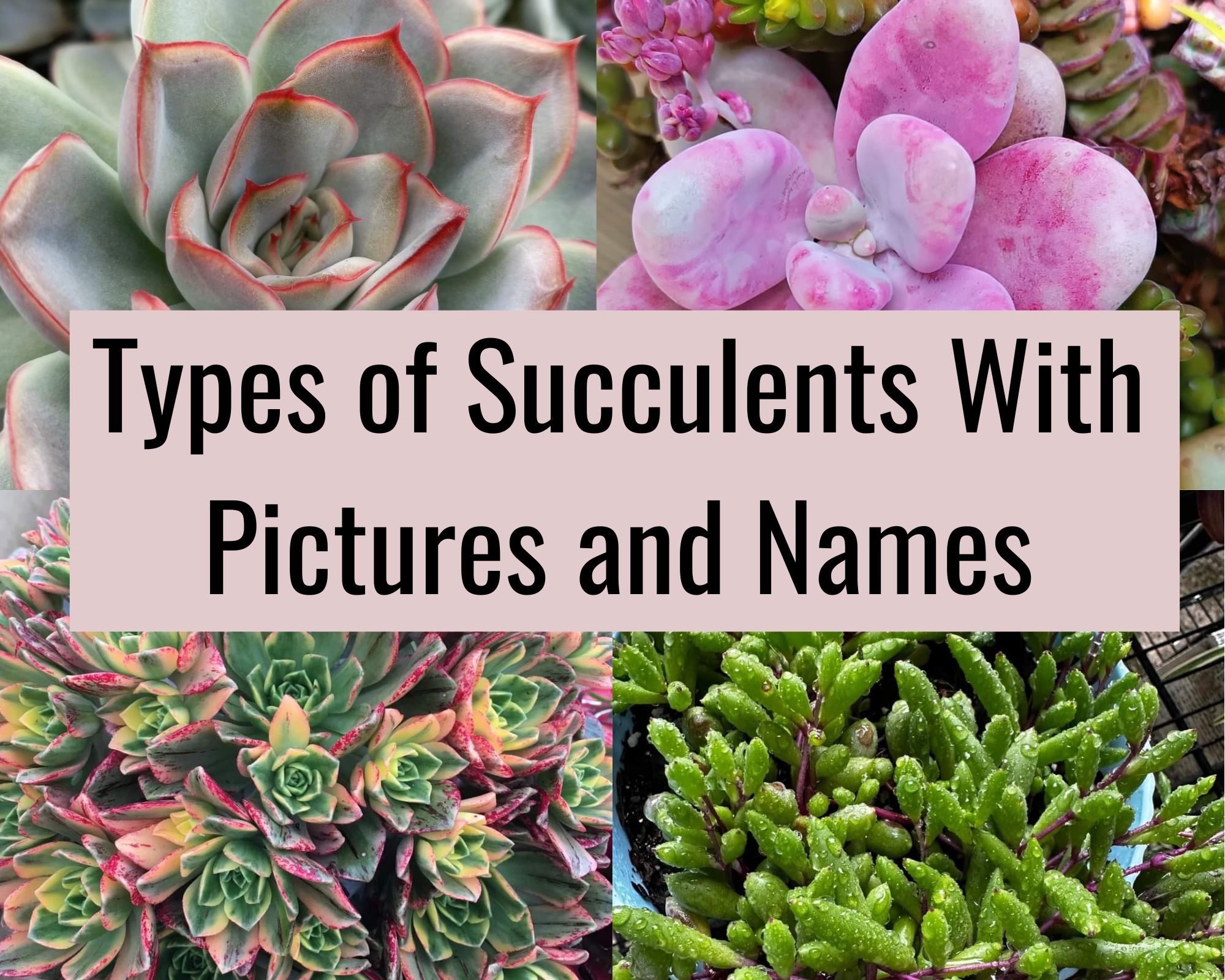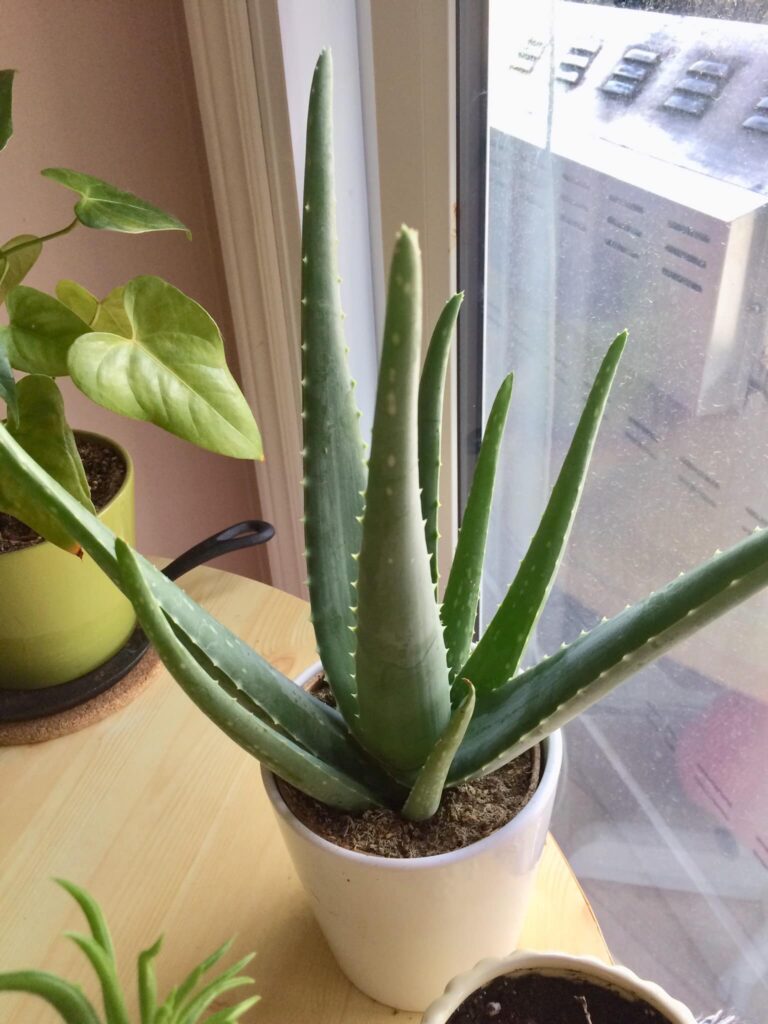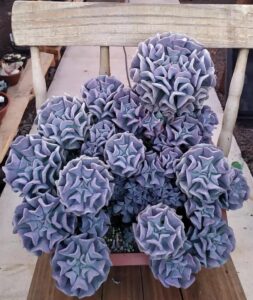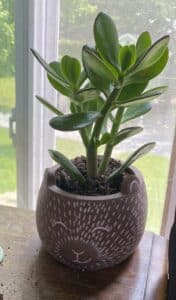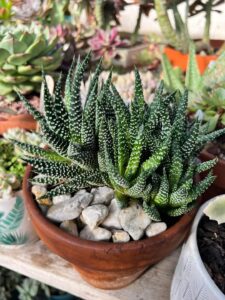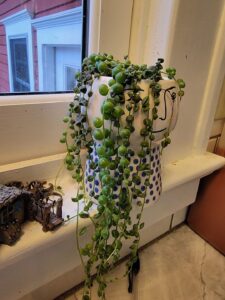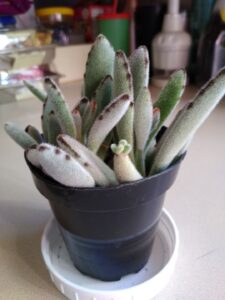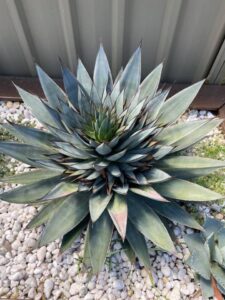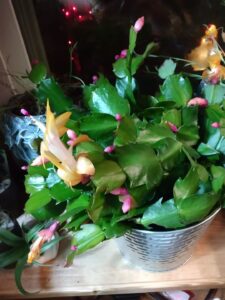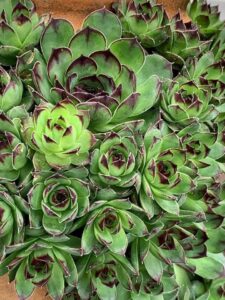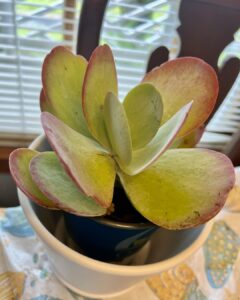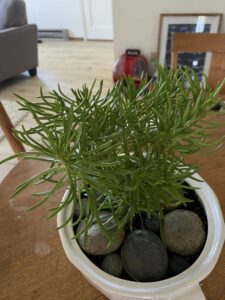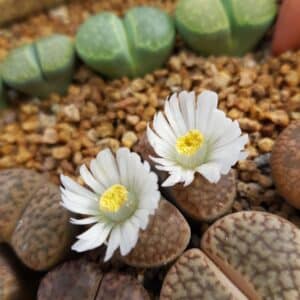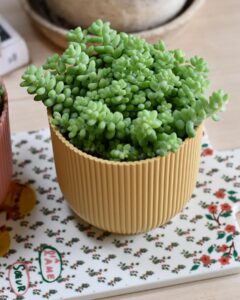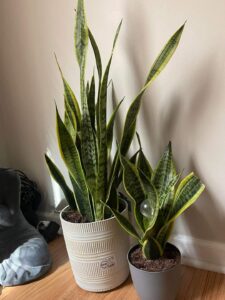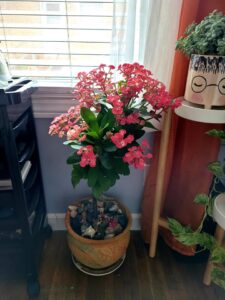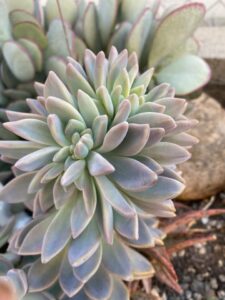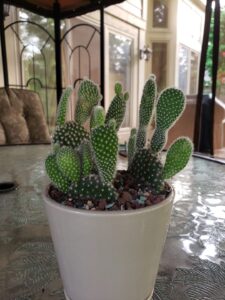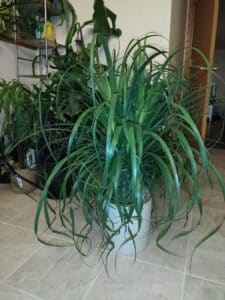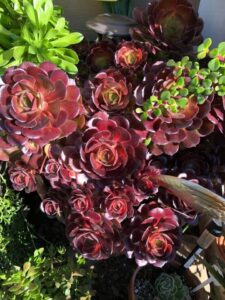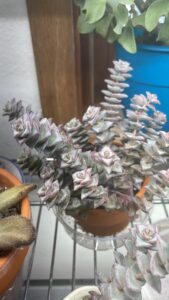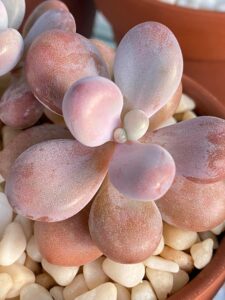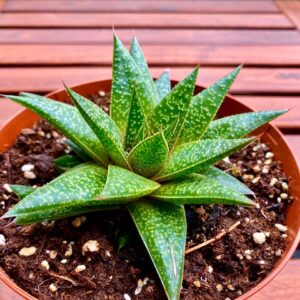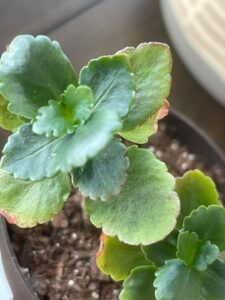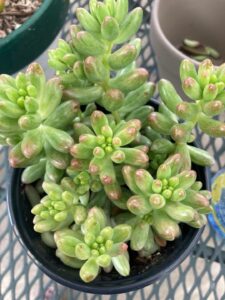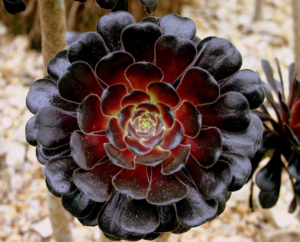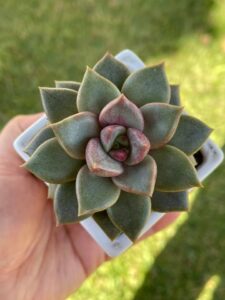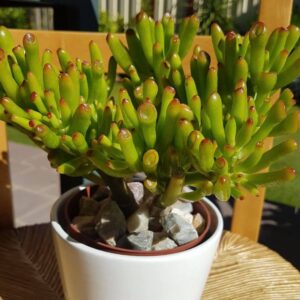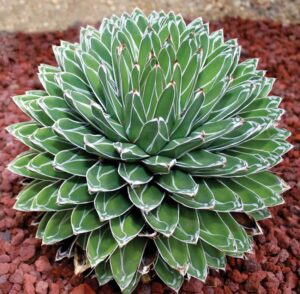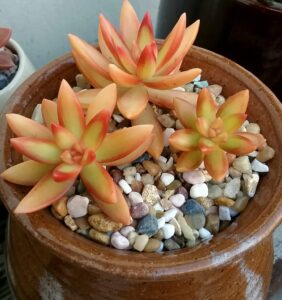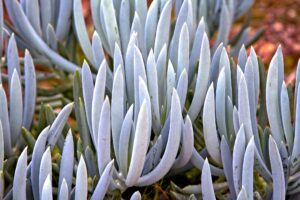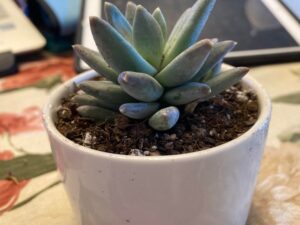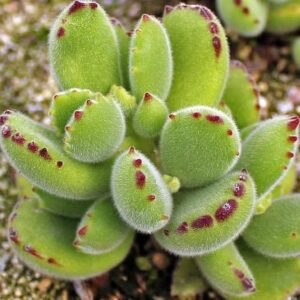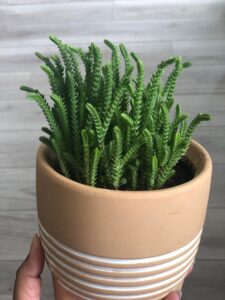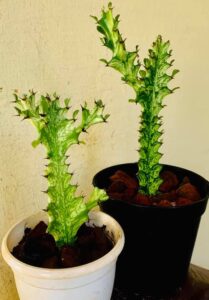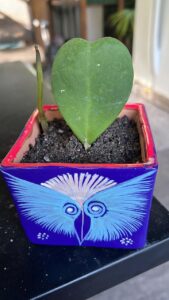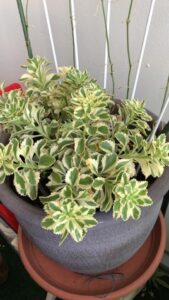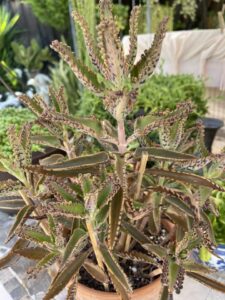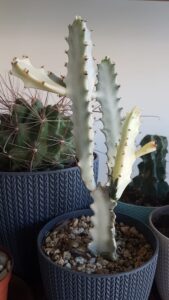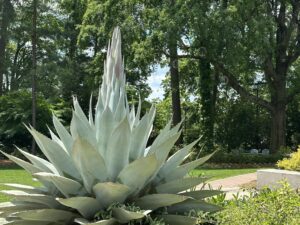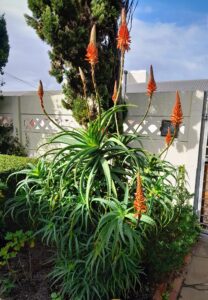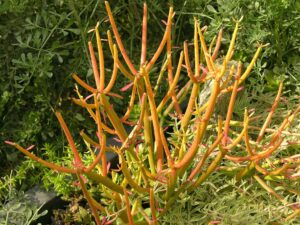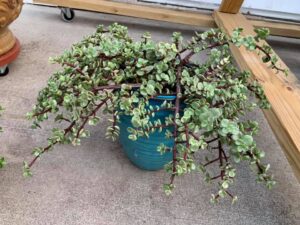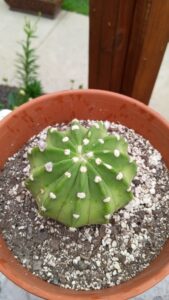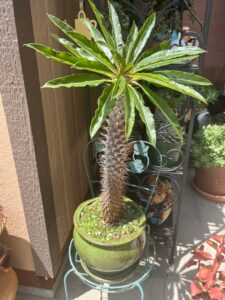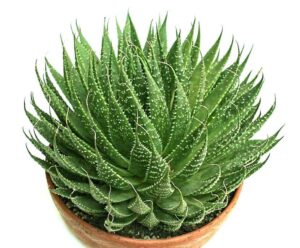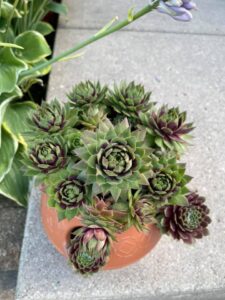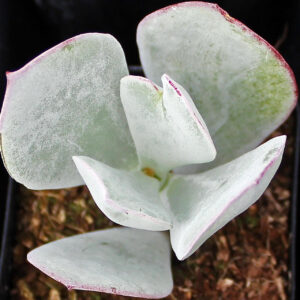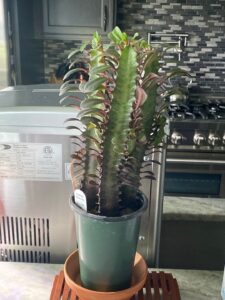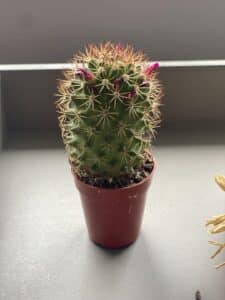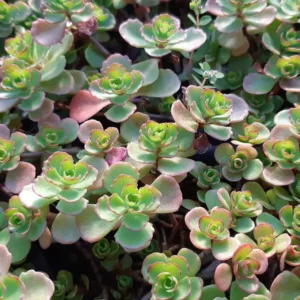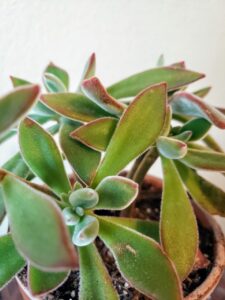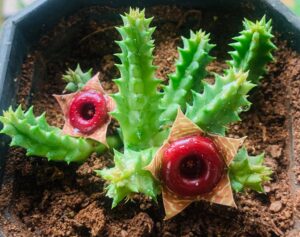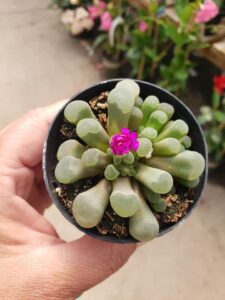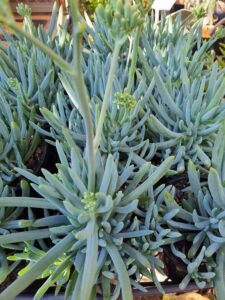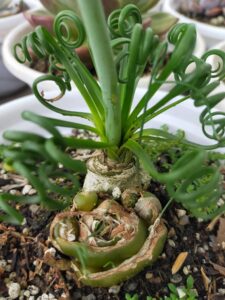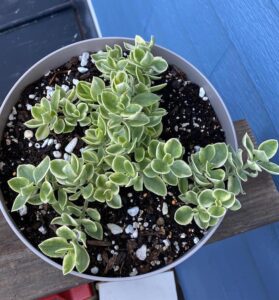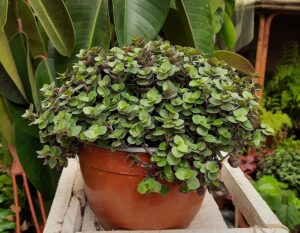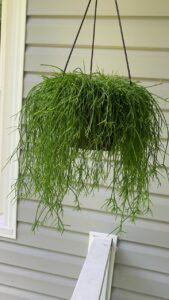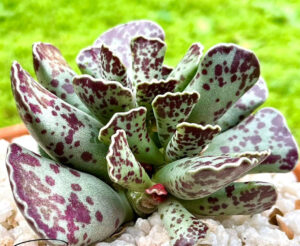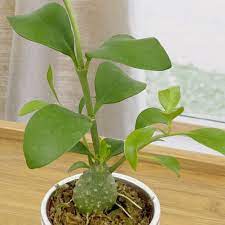Succulents are trendy and sought-after for a reason. They are mother nature’s rebellious artists that adorn our landscapes with elegance and beauty. These resilient plants thrive in arid landscapes and have unlocked the secret to survival in the most unforgiving environments.
That’s not enough; there are thousands types of succulents, each with unique characteristics and adaptations. So, we are spoilt for choice.
How do I tell what kind of succulent I have?
Identifying a specific succulent can sometimes be a bit challenging, especially without a visual reference. However, there are a few steps you can follow to help you determine the type of succulent you have:
1. Observe your Succulent’s overall appearance
Take note of the succulent’s size, shape, and growth habit. Is it a rosette-forming succulent with tightly packed leaves? Does it have trailing or cascading stems? These characteristics can help narrow down the possibilities.
2. Examine the Leaves
Pay attention to the color, shape, texture, and arrangement of the leaves. Are they thick and fleshy or thin and elongated? Are they smooth, hairy, spiky, or have any distinct patterns? Some succulents have leaves arranged in a rosette, while others have alternate or opposite leaf patterns.
3. Check for unique features
Look for any unique characteristics or distinguishing features that set the succulent apart. For example, some succulents have distinct markings, like stripes or dots, on their leaves. Others may have specialized structures such as caudexes (swollen stems) or offsets (small plantlets growing around the base).
4. Consider the growth habit
Take into account the way the succulent grows and spreads. Does it produce offsets or suckers? Does it form clumps or spread via runners or stolons? This information can provide clues about the succulent’s identity.
5. Research and compare
Once you have gathered information about the succulent’s appearance, use online resources, books, or plant identification apps to compare your findings with known succulent species. Look for images, descriptions, and botanical information that match your plant’s characteristics.
If you are still having trouble identifying your succulent, you can take a clear photo of the plant and seek help from succulent communities or plant identification forums online.
Experienced succulent enthusiasts can often provide valuable insights and help you narrow down the possibilities based on visual cues.
Are you a succulent enthusiast? Here are 60 types of succulents.
Related Post: Succulents Identification Chart
60 Types Of Succulents With Pictures
Here are some common succulent species.
1. Aloe Vera
Botanical Name: Aloe barbadensis
Native Area: Arabian Peninsula
Plant Type: Perennial
Size: 1 to 3 inches
Sun exposure: Full Sun
Hardiness Zone: 10 to 11
Toxic To Pets
If not for anything else, you have definitely heard of aloe vera for its medicinal value. It’s commonly used to deal with ailments like skin irritations, cuts, and minor burns, but that aside, what about its ornamental values?
Aloe vera has a distinctive appearance, with thick, fleshy rosette leaves growing in a spiral pattern. The leaves are grey-green or just green with serrated edges lined with small teeth.
Its yellow or orange bear tubular flowers that grow on tall flower spikes enhance its appearance and attract pollinators.
Grow this succulent in well-draining soil and bright sunlight, and be careful not to overwater it.
Also Read: Easiest succulents to grow indoors
2. Echeveria
Botanical Name: Echeveria spp.
Native Area: Central America, Mexico, and Northwestern South America
Plant Type: Perennial
Size: 2 to 24 inches
Sun Exposure: Full
Hardiness Zone: 9-12
Non-Toxic To Pets
You won’t miss echeverias in a list of the types of succulents as they are trendy among succulent enthusiasts and collectors due to their rosette-shaped growth habit and stunning foliage.
Although this plant has numerous species and cultivars, each with unique characteristics, you can recognize an echeveria from their shared traits. These include thick, fleshy leaves that form tight, symmetrical rosettes.
Regarding leaf color, echeveria will grace your home with different colors ranging from shades of green, blue, purple, pink, and even red, often with attractive patterns or edges.
Also Read: Different Types of Purple Succulents
The best part is that these succulents change colors throughout the year and respond to environmental conditions such as sunlight and temperature.
3. Jade Plant
Botanical Name: Crassula ovata
Nativity: South Africa and Mozambique
Plant Type: Perennial
Size: 3-6 Feet
Sun Exposure: Full
Hardiness Zone: 10-12
Toxic To Pets
If you want a succulent that can survive in various living conditions, the Jade Plant is perfect. It loves warm, sunny areas but can tolerate frost as well.
Also, with proper care, this succulent can thrive in or outside your home for several years.
Read more: Best Full Sun Succulents
Besides that, it’s beloved for its attractive, thick, oval-shaped, fleshy leaves and ease of care. As for color, it is typically vibrant green, but you can find varieties with hints of red or yellow in the margins or leaf tips.
As your Jade plant matures, it will develop a woody trunk that adds to its visual appeal.
4. Haworthia
Botanical Name: Haworthia spp
Native Area: Southern Africa
Plant Type: Perennial
Size: 3 to 5 inches
Sun Exposure: Partial, Full
Hardiness Zone: 9-11
Non-Toxic To Pets
The Haworthia genus features more than 150 recognized species, so if you love this plant, you are surely spoilt for choice. This attractive houseplant will happily live indoors, provided it receives bright, indirect sunlight and grows in well-draining soil, and you water it infrequently.
Surprisingly, this succulent doesn’t enjoy full sunlight, and compared to other succulents, it can flourish in low-light conditions.
Do you love aloe vera, but space is an issue? Haworthia is a perfect substitute, so consider it.
This aloe-looking succulent has green, spiky leaves and is generously covered with white bands or warts, creating attractive foliage.
5. String of Pearls
Botanical Name: Senecio rowleyanus
Native Area: South Africa
Plant Type: Perennial
Size: 1 to 2 Feet
Sun Exposure: Partial, Full
Hardiness Zone: 9-12
Toxic To Pets
Whether you want to adorn your living room, bedroom, office, or patio, the string of pearls can adapt to various environments and add a touch of greenery wherever you choose to place it.
Its cascading strands of round, bead-like leaves effortlessly add a touch of elegance and charm to any of your indoor or outdoor spaces.
The spherical leaves are typically green but sometimes have a slightly bluish or grayish tinge. In addition to its delightful foliage, String of Pearls can produce small, white, star-shaped flowers. It’s no wonder succulent enthusiasts cherish this trailing, charming plant.
6. Panda Plant
Botanical Name: Kalanchoe tomentosa
Native Area: Madagascar
Plant Type: Perennial
Size: 1.5 Feet
Sun Exposure: Full
Hardiness Zone: 10-11
Toxic To Pets
Adorable isn’t commonly used to describe a plant, but that’s exactly what the Panda plant is, a highly sought-after type of succulent with soft-fuzzy leaves and an adorable appearance.
The leaves, which are its striking feature, are gray-green, oval-shaped, thick, and covered in a dense layer of tiny hairs, giving them a fuzzy or velvety texture.
It’s well-suited for indoor cultivation, but if you choose to plant it outdoors, ensure you live in an area with a mild climate.
7. Agave
Botanical Name: Agave spp.
Native Area: South America, Central America, and North America
Plant Type: Perennial
Size: 1 inch to 8 Feet
Sun Exposure: Full
Hardiness Zone: 5-11
Toxic To Pets
Agave has eye-catching leaves with sharp, toothed edges and pointed tips, varying in color from green to blue-green, gray, or even variegated patterns. However, as you admire them, do it carefully so you don’t stab yourself.
This striking succulent is loved for its ability to withstand harsh conditions and unique appearance. They are also favored for their ornamental value; that’s why you’ll prevalently see them in landscaping and xeriscaping projects.
8. Christmas Cactus
Botanical Name: Schlumbergera spp.
Native Area: South America
Plant Type: Perennial
Size: 6-12 inches
Sun Exposure: Partial
Hardiness Zone: 10-12
Non-Toxic Pets
Succulents typically stand out for their fleshy leaves, but the Christmas Cactus is much more unique. This plant is popular for its vibrant blooms, particularly at Christmas.
With proper care (proper watering, bright, indirect sunlight, and well-draining soil), the Christmas Cactus will give you many years of enjoyment and beautiful blooms, blooming year after year.
9. Sempervivum
Botanical Name: Sempervivum spp.
Native Area: Europe, the Middle East, and North Africa
Plant Type: Perennial
Size: 1 to 6 Inches
Sun Exposure: Full
Hardiness Zone: 3 to 9
Non-Toxic to Pets
Sempervivum is well-known for its rosette-shaped clusters of fleshy, green, red, brown, or even purplish leaves. However, do you know why it’s highly valued? It’s hardy, resilient, and can form beautiful, compact colonies.
Plant it en masse or combine it with other succulents to create a visually appealing collection. Use it to add texture and beauty to your rock gardens, containers, or dry landscapes.
After all, it can withstand harsh conditions, including bad soil, drought, and intense temperatures.
10. Paddle Plant
Botanical Name: Kalanchoe thyrsiflora
Native Area: South Africa
Plant Type: Perennial
Size: 1 to 3 Feet
Sun Exposure: Full
Hardiness Zone: 9-11
Toxic to Pets
As the name suggests, Paddle Plant is a type of succulent that has unique large flat paddle-shaped leaves, which are bluish-green or grayish-green, thick, fleshy, and grow in a rosette formation.
Expose it to bright light or cooler temperatures, and the leaves may take on reddish or purple hues.
If you plant it indoors, position it near a south-facing window or provide bright, indirect light. On the other hand, if you want the paddle plant as an outdoor succulent, grow it in a location with partial sun or filtered shade.
Want to see Paddle Plant’s small, yellowish-green tubular flowers? Anticipate them in early spring or late winter.
11. Pencil Cactus
Botanical Name: Euphorbia tirucalli
Native Area: Africa and India
Plant Type: Evergreen Shrub
Size: 20 to 30 Feet
Sun Exposure: Full
Hardiness Zone: 11-12
Toxic to Pets
Even without digging deeper into this succulent, it definitely stands out for its appearance. It’s highly valued for vibrant coloration and slender, long thin leaves and pencil-like stems that grow upright, resembling the shape of pencils or sticks.
Provide this plant with ideal growing conditions, and the stems will reach impressive heights.
As you expose it to bright light, Pencil Cactus coloration can vary from green to reddish-orange, with the intensity of the red tones increasing with more light. If you break or cut a stem, a white, milky latex sap will be produced.
This isn’t a big issue until the sap gets into your eyes and skin, irritating the heck out of you, so be careful.
12. Lithops
Botanical Name: Lithops spp.
Native Area: Southern Africa
Plant Type: Perennial
Size: 0.5 to 2 Inches
Sun Exposure: Full
Hardiness Zone: 10-11
Non-Toxic to Pets
Not everyone will find this plant’s unusually rock-like appearance attractive, but it remains highly sought after by succulent enthusiasts and collectors for the same intriguing appearance.
Consider Lithops or living stones if you want something unique for your containers or rock gardens where you can fully appreciate its camouflaged beauty.
Lithops have distinct growth cycles. They typically go through a period of active growth and flowering in the fall and spring, while remaining dormant during the summer and winter. Adjust your watering accordingly.
When Lithops are actively growing, provide a thorough watering but allow the soil to dry out completely between waterings. This method mimics their natural habitat, preventing the risk of overwatering and encouraging healthy root development.
13. Burro’s tail
Botanical Name: Sedum morganianum
Native Area: Mexico
Plant Type: Perennial
Size: 1 to 4 Feet
Sun Exposure: Full, Partial
Hardiness Zone: 10-11
Toxic to Pets
This succulent’s long, cascading stems resemble a donkey’s tail and give it a captivating appearance. On Burro’s tail’s unique, trailing stems are dense clusters of fleshy, bead-like leaves that create a lush and cascading effect.
You may have noticed that this plant is silvery; that’s because of its bluish-green or grayish-green leaves.
Burro’s tail is better off on your hanging baskets or elevated planters to witness its trailing nature in full glory.
14. Snake Plant
Botanical Name: Sansevieria trifasciata
Native Area: West Africa
Plant Type: Perennials
Size: 8 inches to 12 Feet
Sun Exposure: Full, Partial
Hardiness Zone: 9-11
Toxic to Pets
It’s a popular plant, typically grown as a houseplant for its stunning appearance. However, many people don’t know it’s a succulent since it doesn’t look like a typical succulent, but it is. It grows slowly, has thick leaves, and doesn’t need a lot of water.
It gets its name from the fact that long, thick, rigid, upright, sword-like leaves grow vertically from a basal rosette, resembling the shape of a snake.
They are usually dark green, with lighter green horizontal striping or variegation that varies between different cultivars.
The Snake plant’s tolerance to a wide range of lighting conditions is a huge perk.
15. Crown of Thorns
Botanical Name: Euphorbia milii
Native Area: Madagascar
Plant Type: Perennial
Size: 3 to 6 Feet
Sun Exposure: Full, Partial
Hardiness Zone: 9-11
Toxic to Pets
Not to disregard Crown of Thorns’ thick, attractive green or gray succulent stems covered in sharp, thorn-like spines but the real showstopper are the vibrant bracts. These are modified leaves that surround the small, inconspicuous flowers.
The bracts can come in various colors, including red, pink, orange, yellow, and even white, adding a splash of brightness to the plant. For proper care, ensure this plant gets well-draining soil, bright, direct sun, and moderate watering.
16. Ghost plant
Botanical Name: Graptopetalum paraguayense
Native Area: Mexico
Plant Type: Perennial
Size: 6-12 Inches
Sun Exposure: Full to Partial
Hardiness Zone: 9-11
Non-Toxic to Pets
Rosette-shaped, pale blue-green or grayish leaves characterize this succulent. These thick, succulent leaves also display a powdery, ghostly coating that gives the plant its name.
This powdery coating, known as farina, helps safeguard the plant from too much sun exposure and reduces water loss.
The Ghost plant also has a fascinating feature that some other succulents also embody, the ability to change colors depending on the amount of sunlight it receives.
The leaves are vibrant pink or purple in bright light and silvery or grayish-green in lower light conditions.
17. Bunny Ears Cactus
Botanical Name: Opuntia microdasys
Native Area: Mexico
Plant Type: Perennial
Size: 2 to 3 Feet
Sun Exposure: Full
Hardiness Zone: 9a, 9b, 10a, 10b, 11a, 11b
Non-Toxic to Pets
This plant’s bunny rabbit ears-like cute pads covered in golden or yellow glochids may fool you into thinking it’s cuddly. However, while the Bunny Ears Cactus is less intimidating than other cacti with big fierce spikes, it is still prickly.
Bunny ears cacti have low water requirements and are highly drought-tolerant. You can grow it indoors or outdoors.
18. Ponytail Palm
Botanical Name: Beaucarnea recurvata
Native Area: Mexico
Plant Type: Evergreen shrub/ tree
Size: 6-8 Feet
Sun Exposure: Full
Hardiness Zone: 10-11
Non-Toxic to Pets
If you grow this plant indoors, you barely have to do anything else, provided it gets enough water and sufficient light during its growing season. As an outdoor plant, plant it in a succulent/cactus potting mix and place it in an area with plenty of sunlight.
Also Read: How To Make Your Own Succulent Soil
If you want to see it reach up to 30 feet in height, grow it outdoors; otherwise, it will reach around 6 feet indoors.
Remember, Ponytail Palm isn’t a true palm.
19. Aeonium
Botanical Name: Aeonium spp.
Native Area: Africa, Canary Islands
Plant Type: Perennial
Size: 3 to 36 Inches
Sun Exposure: Full, Partial
Hardiness Zone: 9-11
Non-Toxic to Pets
Since Aeoniums come in different shapes, sizes, and colors, you can choose the type that appeals to you most or even mix them for a more striking look. Its rosettes of thick, fleshy leaves grow symmetrically, making the plant stand out.
The growth manner of this succulent is genuinely unique. Aeoniums are monocarpic, meaning that individual rosettes bloom once and then die.
This doesn’t seem like a great feature; I get it. However, the upside is that aeoniums produce offsets or “pups” before blooming, which you can separate and replicate to propagate new plants, thus continuing the growth cycle.
20. String Of Buttons
Botanical Name: Crassula perforata
Native Area: South Africa
Plant Type: Perennial
Size: 1 to 2 Feet
Sun Exposure: Full, Partial
Hardiness Zone: 9-12
Non-Toxic to Pets
I recommend growing this succulent if you tend to forget your plants or are a beginner. This low-maintenance plant requires well-draining soil and prefers bright but indirect light or partial shade but can handle some direct sunlight.
Propagating string of buttons is also super easy; just cut and transplant a healthy stem.
It grows as a trailing or hanging succulent, with the stems cascading down from the container or draping over a pot. This charming succulent beautifies indoor and outdoor spaces.
21. Moonstones
Botanical Name: Pachyphytum oviferum
Native Area: Mexico
Plant Type: Perennial
Size: 4 Inches
Sun Exposure: Full, Partial
Hardiness Zone: 10a-11b
Non-Toxic to Pets
If you are new to plant care, you want a plant that’s easy to care for. Moonstones fit the bill and make excellent houseplants.
Succulent enthusiasts love this plant for their distinctive round, plump leaves and attractive silvery-blue or grayish-green coloration.
It’s crucial to note that moonstones are generally frost-tender and prefer mild to warm temperatures. In that case, protect them from freezing temperatures and provide adequate shelter if grown outdoors in colder regions.
22. Gasteria
Botanical Name: Gasteria spp.
Native Area: South Africa
Plant Type: Perennial
Size: 4 to 24 inches
Sun Exposure: Full, Partial
Hardiness Zone: 9-11
Non-toxic to Pets
Also Read: Succulents that are safe for cats
Like Echeveria, Gasteria is aloe-look alikes but a relatively rare genus that makes a perfect houseplant as it can tolerate low-light conditions.
This slow-growing plant has thick, fleshy, rosette leaves typically triangular or tongue-shaped, often with rough or textured surfaces.
Its attractive leaves are absolutely stunning, but what I love most about Gasteria are its unique tubular or bell-shaped red, orange, or yellow flowers.
23. Flaming Katy
Botanical Name: Kalanchoe blossfeldiana
Native Area: Madagascar
Plant Type: Perennial
Size: 0.5 to 1.5 Feet
Sun Exposure: Full, Partial
Hardiness Zone: 10-12
Toxic to Pets
This succulent is adored and mostly grown for its charming flowers rather than foliage. This lovely succulent brings a burst of color and cheerfulness, whether inside or outside.
There’s more; for a houseplant, Flaming Katy has a long blooming time, so red, orange, pink, yellow, and white bell-shaped beautiful flowers will beautify your spaces much longer.
One more thing, as most plants go dormant in winter and spring, the Flaming Katy will come alive with its blooms.
24. Jelly Bean Plant
Botanical Name: Sedum rubrotinctum
Native Area: Mexico
Plant Type: Perennial
Size: 6-12 Inches
Sun Exposure: Full
Hardiness Zone: 9-11
Toxic to Pets
Looking for a succulent that provides great ground cover? The Jelly Bean Plant has a sprawling growth behavior. Additionally, its stems cascade or trail over the edges of containers, so it looks great in hanging baskets or elevated planters.
If you grow it indoors, ensure it gets bright, filtered light. When outdoors, it can thrive in partial shade or areas that are shaded in the morning and afternoon.
25. Black Rose
Botanical Name: Aeonium arboreum
Native Area: Canary Islands
Plant Type: Perennial
Size: 1-2 Feet
Sun Exposure: Full, Partial
Hardiness Zone: 9-11
Non-Toxic to Pets
Are you looking for a unique, captivating plant that can make your succulent collection more striking or stand out on its own?
The dark burgundy or almost black foliage of the Black Rose will give you just that. For an even more intense color, expose it to direct sunlight or cool temperatures.
Depending on your preference, choose the type that grows on a single stem or one that develops multiple stems and creates a more bushy appearance.
26. Graptoveria
Botanical Name: Graptoveria spp.
Native Area: North America
Plant Type: Perennial
Size: 6 to 18 inches
Sun Exposure: Full, Partial
Hardiness Zone: 9-11
Non-Toxic to Pets
With their stunning rosette formations, diverse colors, and relatively easy care, growing Graptoveria plants offer all you want in a succulent.
It brings out the beauty and charm of succulents whether you grow them in containers, rock gardens, or as part of a succulent collection.
Graptoveria’s thick, fleshy leaves come in shades of green, blue-green, purple, pink, or even variegated patterns with a smooth or slightly rough texture.
27. Gollum Jade
Botanical Name: Crassula ovata ‘Gollum’
Native Area: Africa
Plant Type: Perennial
Size: 3 Feet
Sun Exposure: Full
Hardiness Zone: 9-13
Mildly Toxic to Pets
I don’t think I need to tell you why this succulent is called Gollum if you have watched “The Lord of The Rings.” If not, it’s due to its unique leaf shape resembling Gollum’s elongated fingers, which give it an intriguing and distinctive appearance.
Gollum Jade’s green, smooth, glossy leaves are its main attraction. However, it can produce clusters of small, star-shaped flowers in shades of white or pale pink in late winter or early spring, adding to its lovely appearance.
28. Queen Victoria Agave
Botanical Name: Agave victoriae-reginae
Native Area: Northeastern Mexico
Plant Type: Perennial
Size: 9 Inches to 1 Foot
Sun Exposure: Full
Hardiness Zone: 7-11
Toxic to Pets
Award winning-the Royal Horticultural Society Garden Merit award, beautiful with a symmetrical and architectural rosette of dark green, triangular leaves with striking white markings. These are but a few things that stand out about Queen Victoria Agave.
This visually striking and relatively should be top of your list when looking for a focal point in succulent gardens, rock gardens, or container arrangements.
Despite being a slow-growing succulent, taking several years to reach its mature size, you will love it for its compact and striking appearance.
29. Coppertone Stonecrop
Botanical Name: Sedum nussbaumerianum
Native Area: Mexico
Plant Type: Perennial
Size: 8 to 9 Inches
Sun Exposure: Full
Hardiness Zone: 9-11
Non-Toxic to Pets
This award winner is eye-catching and unique, with attractive foliage and low-maintenance nature. Apart from being an easy-to-grow and care for succulent, many appreciate its fleshy, spoon-shaped leaves that grow in dense clusters.
The leaves have a beautiful coppery to golden-green coloration, which intensifies with increased sunlight exposure.
This plant’s vibrant foliage and cascading growth habit will help you add a touch of warmth and beauty to your succulent displays and rock gardens.
30. Blue Chalksticks
Botanical Name: Senecio serpens
Native Area: South Africa
Plant Type: Annual
Size: 10 Inches to 1 Foot
Sun Exposure: Full, Partial
Hardiness Zone: 9-11
Mildly Toxic to Pets
This ground-hugging, semi-trailing dwarf plant offers impeccable ornamental appeal to rock gardens and containers. Grow it in your home for that added texture and color brought about by its powdery blue to silvery gray leaves.
They are cylindrical, elongated, and slightly curved and resemble small chalksticks.
With the proper care, which comprises well-draining soil, bright sunlight, and limited watering, Blue Chalksticks will thrive and provide year-round beauty in your garden or indoor space.
31. Little Jewel Succulent
Botanical Name: Pachyveria glauca
Native Area: Mexico
Plant Type: Perennial
Size: 3-7 Inches
Sun Exposure: Full Sun, Partial Shade
Hardiness Zone: 9b
Non-Toxic to Pets
The attractive rosettes of Little Jewel’s fleshy leaves make succulent arrangements, rock gardens, or container displays more visually appealing.
This plant has a plump appearance, with the leaves adorning grayish-green or bluish-gray leaves, which may have a powdery or waxy coating.
Be sure to give this succulent plenty of warmth, so it may be best to plant it outdoors in containers that you can easily transfer indoors if necessary. Its edges can develop a pink hue, and the whole plant can sometimes turn pinkish-red.
32. Bear’s Paw
Botanical Name: Cotyledon tomentosa
Native Area: South Africa
Plant Type: Perennial
Size: 6 to 8 Inches
Sun Exposure: Full
Hardiness Zone: 9b-11b
Mildly Toxic to Pets
Do you love small, fuzzy succulents? If that’s the case, you will cherish the Bear’s Paw. Its adorable green or gray-green rounded leaves are covered in fine, silvery hairs, giving them a fuzzy or velvety texture. Expose it to the sun directly, and you may see it develop red or brown tinges.
The Bear’s Paw will showcase its beauty if you give it bright but indirect sunlight, water it correctly, and ensure it grows in well-draining soil. It will fit in perfectly in your rock gardens, containers, or indoor displays.
33. Watch Chain Succulent
Botanical Name: Crassula muscosa
Native Area: South Africa
Plant Type: Perennial
Size: 6 to 12 Inches
Sun Exposure: Full Sun, Partial Shade
Hardiness Zone: 9, 10, 11, 12
Non-Toxic to Pets
This is a fascinating plant with an intriguing growth habit. Think about a chain or a miniature pine tree. That’s what Watch Chain’s dense, overlapping triangular or needle-like shaped leaves with a scale-like appearance resemble.
This small, slow-growing plant forms dense mats or cascades of foliage, so plant it in hanging baskets, rock gardens, or as a ground cover.
You will notice that this plant tends to grow vertically at first and then arches or cascades down, giving it a unique cascading effect.
It’s easy to appreciate this plant’s distinct appearance and easy care requirements whether you’re a new or seasoned succulent grower.
34. Mottled Spurge
Botanical Name: Euphorbia lactea
Native Area: India, Sri Lanka, Thailand
Plant Type: Perennial
Size: Up to 15 Feet
Sun Exposure: Full Sun to Part Shade
Hardiness Zone: 10-11
Toxic to Pets
This plant’s true beauty lies in its unique stems and the striking patterns they exhibit. You probably wonder what these stems look like. Well, here’s a description. Mottled Spurge’s stems are thick, fleshy and resemble cacti. The stems are erect, columnar, and can get up to many feet tall.
Also, they have green, irregular, undulating ridges that can be variegated with creamy white or yellowish patterns, giving the plant its mottled appearance.
The stem segments are typically four- or five-sided and can develop deep, sharp spines along the edges. These spines are ornamental and the plant’s protective mechanism.
35. Lucky Heart Succulent
Botanical Name: Hoya Kerrii
Native Area: Asia
Plant Type: Perennial
Size: 13 Feet
Sun Exposure: Full
Hardiness Zone: 11
Non-Toxic to Pets
Are you looking for the perfect plant to gift your partner on Valentine’s Day, anniversary, or just because you want to get them something? Why not go with a plant with heart-shaped leaves that also symbolizes love and luck?
Apart from being a perfect gift, Lucky Heart is also a delightful addition to indoor spaces. These include offices, living rooms, or bedrooms, where you can appreciate its charming foliage.
Caring for it is also pretty easy, adding to its appeal. It flourishes in bright but indirect light but can handle some shade. As for watering, it prefers to be on the drier side.
36. Sunburst Succulent
Botanical Name: Aeonium ‘Sunburst’
Native Area: Mexico
Plant Type: Perennial
Size: 4 to 6 Inches
Sun Exposure: Full, Partial
Hardiness Zone: 9-11
Non-Toxic to Pets
You will immediately notice Sunburst Succulent for its huge vibrant lime green or yellow-green rosette head that can reach 30 cm (11 inches) wide, making your indoor or outdoor settings burst with color. Its fleshy, triangular leaves grow in tight clusters along the stems.
Sunburst Succulents are tolerant of various temperatures, and although they can withstand mild frost, you are better off growing them in warmer climates.
You will not go wrong planting this succulent as a standalone specimen or with other succulents for a pop of color and texture to succulent gardens, rockeries, or mixed container arrangements.
37. Mother of Millions
Botanical Name: Kalanchoe delagoensis
Native Area: Madagascar
Plant Type: Perennial
Size: Up to 7 Feet
Sun Exposure: Full, Partial
Hardiness Zone: 10-12
Toxic to Pets
This one is for anyone looking for a succulent that can grow taller than you and has a distinctive appearance and unique reproductive strategy.
Mother of Millions can produce numerous plantlets along the edges of its leaves, making it an intriguing succulent to observe and study.
It has gray-green or bluish-green fleshy, elongated leaves with reddish-brown spots. Besides the leaves, orange, bell-shaped flowers can also enhance the plant’s appearance.
38. Candelabra Spurge
Botanical Name: Euphorbia ammak ‘Variegata’
Native Area: Africa
Plant Type: Semi-deciduous
Size: Up to 20 Feet
Sun Exposure: Full
Hardiness Zone: 9-11
Toxic to Pets
Do you love cactus and have enough space for a succulent that can grow up to 20 feet? Let me suggest planting a Candelabra Spurge. It may not be a true cactus, but it looks like one.
Its elongated, slender leaves adorn the cacti’s distinct green color, but its attractive variegation sets the Variegata variety apart.
The leaves display a beautiful mix of creamy yellow or ivory coloration along the edges or in irregular patterns throughout the foliage. This variegation adds a striking contrast and visual interest to the plant.
39. Century Plant
Botanical Name: Agave americana
Native Area: Mexico
Plant Type: Perennial
Size: 6-10 Feet
Sun Exposure: Full
Hardiness Zone: 9-11
Toxic to Pets
There are plenty of reasons to choose Century Plant as a focal point in your xeriscape gardens, rock gardens, or landscape design. Maybe you admire its architectural beauty, long lifespan, or stunning flowering display. Either way, this plant remains a captivating and revered succulent.
It has a slow growth rate and takes many years, usually 10 to 30 years, to become mature and generate a flower stalk.
However, don’t let its name fool you; you won’t have to wait a whole century to see its tall flowering stalk that bears clusters of yellowish-green flowers.
40. Tree Aloe
Botanical Name: Aloidendron barberae
Native Area: South Africa
Plant Type: Perennial
Size: 30 to 40 Feet
Sun Exposure: Full, Partial
Hardiness Zone: 9-11
Non-Toxic to Pets
If you want a beautiful, towering succulent? The Tree Aloe reaches impressive heights of 30-40 feet. It’s also characterized by a thick, robust, grayish-brown trunk with a rough, peeling texture. As it matures, it develops a distinctive cylindrical shape, tapering towards the top.
At the top is a crown of green or bluish-green, thick, long, lance-shaped rosette leaves with small, sharp teeth on the edges. It produces showy, tubular flowers in late winter to early spring.
41. Firestick Plant ‘Sticks on Fire’
Botanical Name: Euphorbia tirucalli
Native Area: Africa and parts of India
Plant Type: Evergreen Succulent Shrub
Size: 4-8 Feet
Sun Exposure: Full
Hardiness Zone: 10-12
Toxic to Pets
The fiery beauty of this plant’s stems suits indoor and outdoor spaces. The stems, which are its focal point, start off green and gradually transition to a brilliant combination of yellow, orange, and fiery red hues, particularly during periods of bright sunlight or cooler temperatures.
Its leaves don’t do much regarding its appearance because they are tiny, inconspicuous, and appear as small scales along the stems. It can withstand a range of temperatures, including mild frost, for short periods. However, if you keep it in freezing temperatures for a prolonged period, protect it.
42. Elephant Bush
Botanical Name: Portulacaria afra
Native Area: South Africa
Plant Type: Perennial
Size: 8-15 Feet
Sun Exposure: Full, Partial
Hardiness Zone: 9-11
Non-Toxic to Pets
So, the Elephant Bush not only beautifies your home, but you can also use it to dress your soups and salads. Moreover, it eliminates excess carbon, thus purifying the air.
Evidently, there are plenty of reasons to introduce this plant to your home as a houseplant, in containers, or as part of a landscape to add beauty and resilience to your succulent arrangements.
In its natural habitat, you will often see this succulent in rocky or sandy soils. Its foliage resembles an elephant’s trunk featuring bright green, thick, fleshy, and roundish leaves growing in opposite pairs along reddish-brown stems.
43. Ball Cactus
Botanical Name: Parodia magnifica
Native Area: Brazil, Uruguay, and Argentina
Plant Type: Perennial
Size: 3-4 Inches
Sun Exposure: Full, Partial
Hardiness Zone: 9-12
Non-Toxic to Pets
This succulent defines uniqueness thanks to its striking spines, spherical shape, and sparkling flowers. This compact plant has a globular growth habit, forming a ball-shaped body.
The cactus’ distinctive texture comes from its numerous rounded segments, also known as ribs, that are covered with prominent tubercles or bumps.
Clusters of yellow or pale, short, rigid spikes cover its body, giving it a dense, spiky appearance. The Ball Cactus also produces vibrant flowers in spring or early summer that add a splash of color to its spherical body.
44. Madagascar Palm
Botanical Name: Pachypodium lamerei
Native Area: Madagascar
Plant Type: Perennial
Size: 12 to 24 Feet
Sun Exposure: Full
Hardiness Zone: 9-12
Toxic To Pets
This is another worthy option for lovers of tall succulents, as it can reach 24 feet high. Despite the name, this plant is not a real palm, but its original home is Madagascar.
It can tolerate drought, flourishes in arid areas, and is highly prized because it can thrive indoors.
Its appearance is also a major reason succulent enthusiasts value it. It has a thick, bulging trunk that tapers gradually towards the top, resembling a bottle or a palm tree.
As for its leaves, they are vibrant green, long, narrow, leathery, rosette, and arranged in a spiral pattern.
45. Torch Plant Succulent
Botanical Name: Aristaloe aristata
Native Area: South Africa
Plant Type: Perennial
Size: Up to 8 Inches
Sun Exposure: Full, Partial
Hardiness Zone: 7-10
Non-Toxic to Pets
I am easily drawn to succulents that can flower. In spring or early summer, the Torch Plant produces tall flower stalks reaching up to 2 feet that bear tubular, coral-red to orange-red flowers arranged in dense clusters.
On their own, these flowers are beautiful and vibrant, but they also attract pollinators like hummingbirds and bees, adding a burst of color and liveliness to the plant.
Another part of its appeal lies in the compact rosette of grayish-green to bluish-green, thick, triangular leaves with distinctive toothed edges.
46. Hens and Chicks Succulent
Botanical Name: Sempervivum tectorum
Native Area: Europe
Plant Type: Perennial
Size: 3-6 Inches
Sun Exposure: Full
Hardiness Zone: 3-8
Non-Toxic to Pets
Don’t get me wrong, Hens and Chicks Succulent has attractive, fleshy, thick, and triangular leaves, typically green but may exhibit shades of red, purple, or silver.
However, what fascinates me about this plant is its unique reproductive strategy.
The main rosette “hen” produces numerous offsets, or “chicks,” that cluster around it, forming a dense mat-like arrangement. Over time, these offsets can grow and fill in spaces, creating a beautiful and intricate display.
47. Pig’s Ear
Botanical Name: Cotyledon orbiculata
Native Area: South Africa
Plant Type: Perennial
Size: 2-4 Feet
Sun Exposure: Full
Hardiness Zone: 9-11
Toxic to Pets
Named after the shape and texture of its leaves, which are thick, fleshy, almost circular, or oval, and resemble a pig’s ear, this succulent is eye-catching.
The leaves have a smooth, glossy texture and are typically bluish-green or grayish-green and can have a reddish or purplish tinge, especially in response to sunlight or stress.
Expose Pig’s Ear to adequate sunlight for those red, orange, and yellow to pink or white clusters of tubular, bell-shaped flowers atop long stalks.
48. African Milk Tree
Botanical Name: Euphorbia Trigona
Native Area: Central Africa
Plant Type: Perennial
Size: Up to 6 Feet
Sun Exposure: Partial
Hardiness Zone: 9b-11
Toxic to Pets
If you grow this majestic plant outdoors, it can grow up to 6 feet. However, grow it indoors if you want to keep it small, typically between 2-4 feet. The three-sided stem with prominent sharp spines along its edges is usually green.
Still, it can develop shades of reddish-brown or purple under certain conditions, such as exposure to bright light or cool temperatures.
This fascinating succulent is worth considering for your succulent arrangements but handle it cautiously because it produces a toxic sap.
49. Pincushion Cactus
Botanical Name: Mammillaria crinita
Native Area: North, Central, and South America
Plant Type: Perennial
Size: Up to 3.2 Inches
Sun Exposure: Full
Hardiness Zone: 9-10b
Non-Toxic to Pets, But Ingestion can Cause Physical Irritation or Injuries
Succulents truly do come in all shapes, and Mammillaria is a testament to how unique these plants can be. This tiny drought-tolerant cactus has dark green globose and cylindrical short stems that have conical tubercles with spines clusters.
However, the real showstoppers are the small, tubular flowers that emerge from the top of the cactus or between the tubercles. They come in a variety of colors, including white, yellow, pink, red, or orange. Also, some species produce brightly colored fruits after flowering.
50. Roseum Succulent
Botanical Name: sedum spurium
Native Area: Europe, Asia
Plant Type: Perennial
Size: 4-6 Inches
Sun Exposure: Full, Partial
Hardiness Zone: 3-9
Non-Toxic to Pets
The primary reason Roseum is widely cultivated is its ornamental properties. Consider it for ground cover, rock gardens, and borders if you need vibrant flowers to add color to your spaces or a plant with a trailing growth habit.
It forms dense mats of small, fleshy leaves arranged in a spiral pattern along trailing stems. These leaves are succulent and have a rounded shape with a blue-green or gray-green color. In cooler temperatures or increased sun exposure, the foliage can take on reddish or purplish tones.
You will have to wait until summer for those clusters of small, pink, star-shaped flowers.
51. Plush Plant
Botanical Name: echeveria pulvinata
Native Area: Mexico
Plant Type: Perennial
Size: Up to 12 Inches
Sun Exposure: Full, Partial
Hardiness Zone: 9-11
Non-Toxic to Pets
Do you want a plant to place on your indoor spaces, windowsills, outdoor containers, succulent arrangements, or dish gardens? Let me introduce you to Plush Plant, which has white, fine hairs that shimmer in the sunlight, making the plant appear silvery.
Its soft, fuzzy leaves will help you create beautiful and texturally diverse displays. These leaves are typically green but can develop reddish or purplish hues, especially along the leaf margins or under intense sunlight.
It can also produce tall flower stalks with clusters of small, orange or yellow, star-shaped flowers for a delightful touch of color.
52. Lifesaver Succulent Plant
Botanical Name: Huernia zebrina
Native Area: Southern Africa
Plant Type: Perennial
Size: 6-8 Inches
Sun Exposure: Full, Partial
Hardiness Zone: 10-11
Non-Toxic to Pets
You couldn’t mistake a Huernia for another succulent even if you tried, thanks to the peculiar shape and pattern of its flowers, which resemble lifebuoys or lifesaver candies.
They are the plant’s highlight, emerging from the base of the stems, and are typically solitary or grow in small clusters.
These flowers have a star-shaped structure and are often a striking combination of colors, such as dark red or maroon, with yellow or white patterns.
Due to their small size, decorate your indoor areas with Lifesaver Plants.
53. Baby Toes Succulent
Botanical Name: Fenestraria rhopalophylla
Native Area: Namibia, South Africa
Plant Type: Perennial
Size: 3 Inches
Sun Exposure: Full
Hardiness Zone: 9-11
Non-Toxic to Pets
Baby Toes are popular in the succulent community due to their unique shape and intriguing windows on their leaves.
They are green or blueish-green, thick, succulent, resemble stubby cylindrical toes or fingers, and have translucent areas or windows near their tips.
This plant protects itself from excess evaporation and intense sunlight by burying the leaves in the soil and only exposing the air and windows to the air. This low-maintenance, resilient succulent is suitable for rock gardens, succulent arrangements, and indoors.
54. Chalk Stick Plant
Botanical Name: Echidnopsis cereiformis
Native Area: Southern Africa
Plant Type: Perennial
Size: Up to 8 inches
Sun Exposure: Full sun
Hardiness Zone: 10-11
Mildly Toxic to Pets
The waxy coating covering the fleshy, upright stems of Chalk Stick Plants gives them a chalky appearance which the plant is known for. However, that’s not all; it protects it from the intense sun.
The leaves are not prominent or visible on the stems, but small, star-shaped flowers that emerge from the tips of the stems add to the stems’ unique structure and coloration. Usually, the flowers are pink or purple, but sometimes you may see them in white or yellow colors.
55. Frizzle Sizzle
Botanical Name: Albuca spiralis
Native Area: South Africa
Plant Type: Perennial
Size: 12-24 Inches
Sun Exposure: Full
Hardiness Zone: 9-11
Non-Toxic to Pets
With curly, spiraled-shaped leaves, the Frizzle Sizzle is an absolute attention-grabber and conversation starter. It brings out that touch of whimsy and playfulness, so you will want to place it in a spot that will let it stand out and display its beauty.
The long, narrow, twisty leaves are usually green but can also be light green to silvery-gray hue. For additional color, its clusters of small, star-shaped flowers are yellow or greenish-yellow and have a pleasant fragrance.
56. Heartleaf Ice Plant
Botanical Name: Aptenia cordifolia
Native Area: South Africa
Plant Type: Perennial
Size: Up to 4 Inches
Sun Exposure: Full, Partial
Hardiness Zone: 9-11
Non-Toxic to Pets
The Heartleaf Ice Plant has both attractive foliage and vibrant flowers going for it. The leaves are deep green, small, fleshy, glossy, and heart-shaped, giving rise to its common name, “Heartleaf.” Moreover, they are densely packed along trailing stems, forming a dense mat of foliage.
As for the flowers, they are eye-catching, vibrant, and daisy-like and come in shades of bright pink, magenta, or red. They have numerous petals arranged in a star-like pattern, creating a striking display against the backdrop of the green foliage.
You won’t regret adding this versatile, resilient plant to your gardening projects, provided you care for it, of course.
57. Creeping Inch Plant
Botanical Name: Callisia repens
Native Area: Mexico, The Caribbean, Central America
Plant Type: Perennial
Size: Up to 4 Inches
Sun Exposure: Bright But Filtered Sunlight
Hardiness Zone: 9-11
Mildly Toxic to Pets
Hang the Creeping Inch Plant for its beautiful trailing habit, or use it as a groundcover or a filler in mixed plantings. There are plenty of ways to showcase this plant indoors or outdoors.
The trailing stems are delicate and have vibrant green, glossy, fleshy, oval-shaped leaves growing on them.
Avoid trimming the stems, and they will grow several feet long. Despite not being showy, small, inconspicuous white flowers make the plant even more charming.
58. Mistletoe Cactus
Botanical Name: Rhipsalis spp.
Native Area: Central and South America
Plant Type: Perennial
Size: Up to 6 Feet
Sun Exposure: Partial, Shade
Hardiness Zone: 9a, 9b, 10a, 10b
Non-Toxic to Pets
Add green and elegance to your indoor spaces with this popular houseplant for its trailing habit and stunning pencil-thin foliage. If you let it, the stems will grow many feet long, creating a beautiful cascading effect.
On the other hand, small, inconspicuous white or cream-colored flowers that typically bloom in spring or summer add to the plant’s appeal. After flowering, green, tiny, round berries that eventually turn white or reddish when ripe emerge. They add an extra ornamental value to the plant.
59. Plover Eggs Succulent
Botanical Name: Adromischus cooperi
Native Area: South Africa
Plant Type: Perennial
Size: Up to Inches
Sun Exposure: Full Sun, Partial Shade
Hardiness Zone: 9-11
Non-Toxic to Pets
This plant will happily live in pots for its entire life, thus perfect for your succulent container arrangements. That way, you can admire its compact growth habit and unique leaf texture. However, you can add it to your rock gardens.
The rosettes in this small, slow-growing succulent are usually solitary, but they can occasionally offset to form small clusters. On the other hand, its small, tubular flowers have shades of pink, white, or purple.
60. Ant Plant
Botanical Name: Dischidia pectinoides
Native Area: Southern Asia
Plant Type: Perennial
Size: 1-3 Feet
Sun Exposure: Full
Hardiness Zone: 10-12
Non-Toxic to Pets
The loose, thin leaves of the Ant Plant can deceive you into thinking it’s not succulent. This epiphytic plant features cascading vines with small, oval-shaped, succulent leaves with serrated edges. Cultivate it in hanging baskets or mounted on cork bark or other supports to showcase its trailing growth habit.
One crucial thing to note about the Ant Plant is that it doesn’t keep as much water as other succulents, so it needs more attention.
Summary
Refer to this list for tall, tiny, indoor, outdoor, and any other types of succulents and experience their majestic beauty and uniqueness. Succulents are not only resilient, low-maintenance plants, but some offer other benefits like medicinal properties. Remember, if you can’t decide on one succulent, get two or even Three.

Hey there, fellow plant enthusiasts! I’m Rachel, the green-thumbed writer behind Rooted In Garden. With a deep-rooted love for all things botanical, I’ve made it my mission to help you cultivate a thriving collection of houseplants. As a devoted plant parent myself, I understand the joys and challenges that come with nurturing these leafy wonders. Whether you’re a succulent aficionado, an orchid enthusiast, or simply adore all potted flora, join me on this journey as we explore the secrets to growing and caring for our beloved green companions. Together, let’s create a flourishing oasis indoors.

